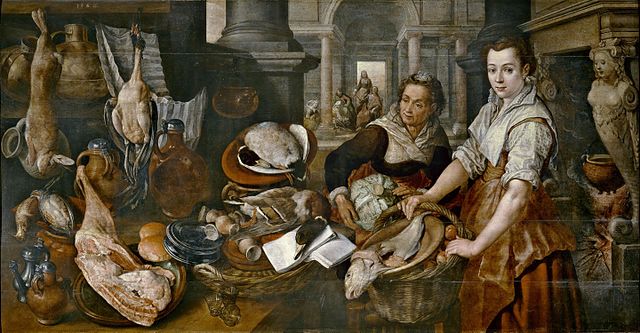“Christ at home with Martha and Mary”, by Joachim Beuckelaer, 1568, courtesy of Wikimedia Commons
Daily Office Readings for Friday, October 26, 2018:
Ecclesiasticus (Sirach) 11:2-20; Revelation 9:13-21; Luke 10:38-42
In the story of Mary and Martha, it’s easy to get caught up in a false dualism. Traditionally, when studying this passage, Martha inevitably gets the short end of it. Mary is praised for her stillness, her ability to sit at Jesus’ feet and patiently listen, and Martha gets dissed for being busy and distracted. Contemplation is ranked above action.
Yet all of us know in our heart of hearts that the glue that holds our individual congregations together is made up of both Marys and Marthas (and that Marys and Marthas exist in both female and male bodies). Yes, we need the Marys–those quiet and devoted prayer superheroes and students of the Bible–they always bring us back to what our shared life is about. Yet at the same time, we need the Marthas–marathoners who pray with their hands and feet. In a healthy congregation, we have both. In a balanced Christian life, we do both.
It doesn’t help that for centuries, this message of “Mary over Martha” has been spread by…well…a patriarchy…in the church. I remember a few years ago when I heard a (male) priest giving more or less the “traditional” approach to this passage, praising Mary, and scolding Martha. I sat there thinking about how all the things that make Sunday morning happen–mowing the yard in the summer, shoveling the snow in the winter, all the things Altar Guild does on Saturday, the devotion of those who prepare for coffee hour–had all just been negated through his words. As I sat there, I found myself getting angrier and angrier–and I really had to resist the urge to throw a prayer book at him. “Contemplate THIS!”
What happens when we look at this passage in a non-dualistic way? Although it’s easy to claim this stems from a more recent feminist theology, in fact, dissenters who warn against the false dualism in this passage have been around since at least the 4th century. John Chrysostom wrote that Jesus’ counsel to Martha was neither reproof nor a choice of contemplation over action. He suggested that the bigger “story within the story” was that Jesus had just come through the front door, and what Mary had done was recognize that when Jesus shows up in your house, to live in the now, to seize the Jesus moment, to be aware of the liminality of kairos time as opposed to chronological time. Several other historical theologians have taken a non-dualistic approach with slightly different takes as to “why”–Augustine of Hippo, Bernard of Clairvaux, Meister Eckhart. John Calvin found himself in a bit of a theological quandary viewing it in this fashion, because he tended to lean towards virtuous living, yet at the same time championed work as a positive human endeavor, ordained by God.
When we read this story through non-dualistic lenses, it no longer becomes a story about two sisters, one “better” than the other; it becomes a story of servant leadership (the Greek word used for Martha’s work is diakonia–as in “deacon”.) When we worship on Sundays, we are being informed by what happens at both halves of our liturgy–word and table. Contemplation and action are two sides of the coin that makes up our Christian life, and they are represented in both halves of our Eucharistic liturgy. Mary and Martha are not competitors in ministry; they are partners in ministering to Jesus. Through that lens, Mary’s “better part” in it is not about Mary; it’s about taking care to always remember the source and the ultimate purpose of all ministry when it’s tempting to be bound up in the details of its execution. It’s about finding the kairos moments in our heavily chronos lives.
When is a time you found a Jesus moment in the busy-ness of ministry?
Maria Evans splits her week between being a pathologist and laboratory director in Kirksville, MO, and gratefully serving in the Episcopal Diocese of Missouri . She presently serves as Interim Assistant Priest at two churches, Church of the Good Shepherd in Town and Country, MO, and St. Luke’s Episcopal Church in Manchester, MO, as they explore a shared ministry model.

